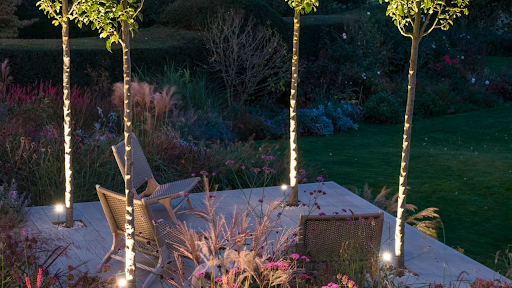Walk through a quiet New Zealand street at night. Some gardens vanish completely. Others—well, they seem to breathe. A faint shimmer on a leaf, a soft glow tracing a path, the faint warmth against the edge of a wall. It’s not luck or money. It’s light—precisely placed, gently balanced. The difference is striking. With well-considered garden lights in NZ, even a modest space feels layered, awake, somehow more alive after dark.
Why Lighting Is the Silent Designer of Outdoor Spaces
Lighting often comes last, treated like an accessory, not a foundation. But it isn’t just about visibility. It’s about mood, tension, rhythm. The way light and shadow fall can alter your sense of space completely. You’re not just seeing; you’re feeling it.
In a country where dusk lingers, where people cook outside, talk outside, live outside—neglecting the evening hours is a quiet loss. Imagine sitting on your deck, your garden barely visible, shapes blending into shadow. Now flip that image. The same garden, same furniture, yet a beam of soft gold skims across a tree trunk, a dim pool of light holds the path, the air hums with warmth. That’s what difference looks like when light is thought through. It’s not decoration—it’s choreography.
How New Zealand’s Climate Shapes Outdoor Lighting Choices
Designing lighting for New Zealand isn’t like designing for somewhere still and dry. The weather has moods. Coastal air eats metal; winter frost cracks fittings. Durability isn’t a suggestion—it’s a necessity. Copper and stainless steel outlast most materials near the sea. Powder-coated aluminum? It stands up better inland. Small choices, big results.
Solar options are popular, of course, but they have limits. Short winter days mean limited charge. So placement is key—keep those panels in the open, angled just right. And if you want consistency, hybrid solar systems with battery backups are worth the investment.
Light temperature is another detail people often miss. Cold white light (4000K and above) looks sterile, almost hospital-like. Warm tones (2700K–3000K) melt into the landscape naturally, letting greens stay rich and shadows soft. A subtle tone shift can decide whether your garden feels alive or artificial.
Design Principles That Separate Ordinary from Striking
The trick isn’t more lights—it’s smarter ones. A good garden doesn’t scream with brightness. It whispers. It hides light behind leaves, under benches, around corners. The idea is to make the source invisible and the effect unforgettable.
Think about how your eyes travel at night. One spotlight on a sculptural flax might stop you for a second. A faint glow beneath a stone wall guides you onward. A balance of darkness and glow keeps the space breathing. Over-lighting kills that rhythm—it’s the visual equivalent of shouting.
Avoid symmetry. Real nature isn’t symmetrical. Let spacing vary. Let shadows fall where they may. That irregularity is what makes it believable. And if you can, play with reflection. Water, stone, even wet bark will bounce light in unpredictable ways. Some of the most memorable garden lights in NZ installations don’t aim at what’s beautiful—they let beauty emerge from where the light lands.
Integrating Function with Subtle Emotion
Lighting isn’t a checklist. It’s storytelling. Each area of your garden should say something slightly different. What happens at the deck should feel different from what happens by the trees.
For conversation zones, keep it low, warm, almost candle-like. You don’t need to flood faces with brightness—just a soft wash that keeps the moment close. Viewing gardens from inside? That’s a different story. A single focal point—say, a lit tree framed by a window—extends your living room into the night. The boundary between inside and out dissolves.
Motion lights can do more than deter intruders. When tuned right, they create moments. A soft bloom of light as you walk down a path feels interactive, personal. The space seems to respond. That sense of quiet movement keeps the garden alive.
Sustainability and Craftsmanship
Here, sustainability means more than just saving energy. It means choosing lights that last, materials that don’t corrode, and systems that don’t demand endless maintenance. Many homeowners in New Zealand are turning to local lighting makers who build for our specific climate. Marine-grade metals, sealed fittings, replaceable components—they’re small upgrades that pay off for years.
LEDs dominate now, not just for efficiency but for precision. They give designers more control—over warmth, direction, and intensity. Less waste, less power, longer life. But the deeper win is emotional sustainability: creating spaces that you actually use and love after dark.
A Garden That Lives Beyond Daylight
In the end, the most beautiful lighting disappears into the background. You forget it’s even there. What remains is feeling—a sense of place, of comfort, of quiet drama. And that’s the true power of thoughtful design.
So, next time you step outside after sunset, pause for a moment. Notice what’s missing. Then imagine what could be—if you let garden lights in NZ become not the decoration, but the language of your night.

